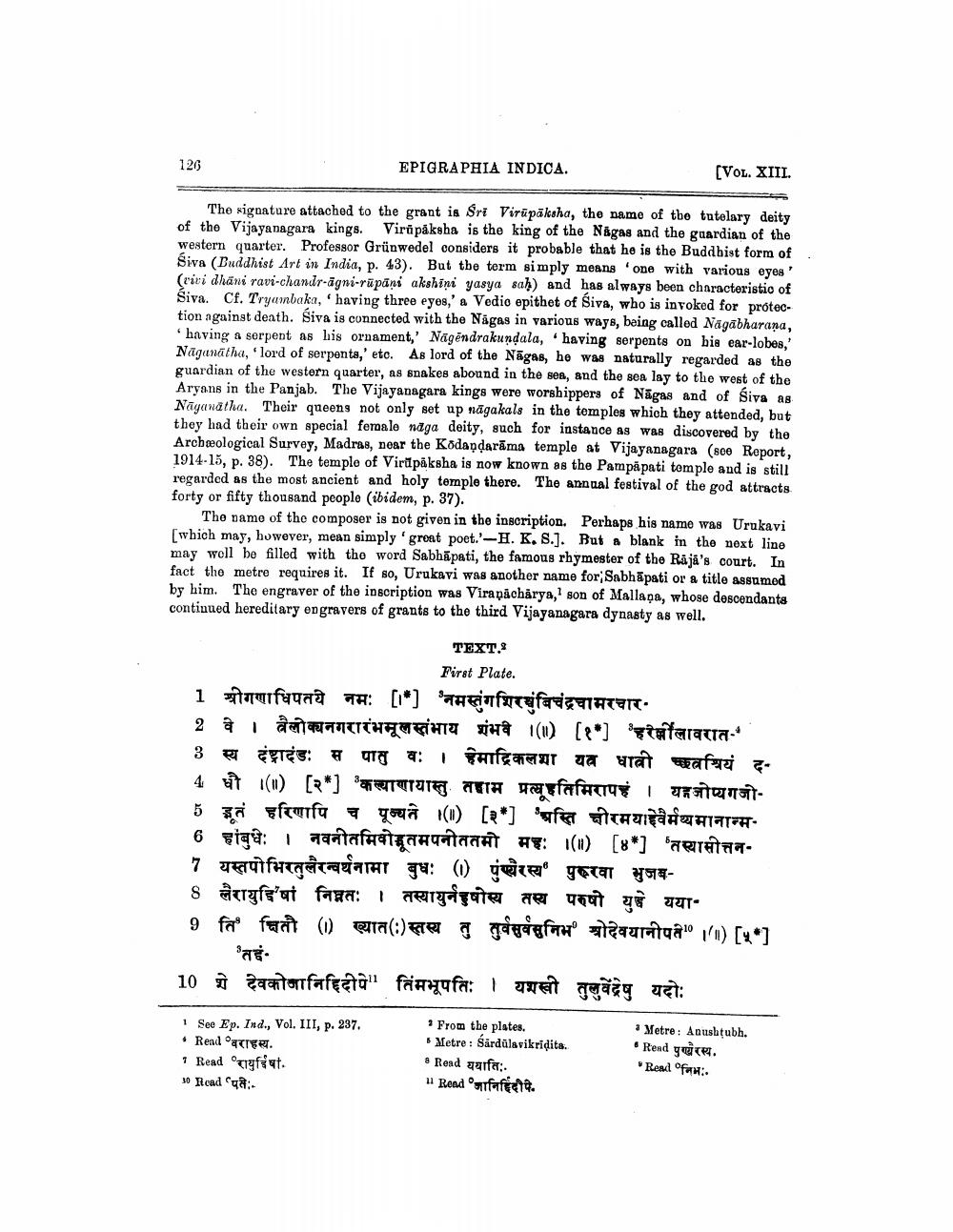________________
120
EPIGRAPHIA INDICA.
[VoL. XIII.
The signature attached to the grant is Sri Virūpāksha, the name of the tutelary deity of the Vijayanagara kings. Viräpäksha is the king of the Nägas and the guardian of the western quarter. Professor Grünwedel considers it probable that he is the Buddhist form of Siva (Buddhist Art in India, p. 43). But the term simply means 'one with various eyes' (rivi dhāni ravi-chandr-āgni-rūpāni akshini yasya sah) and has always been characteristic of Siva. Cf. Tryambaka, having three eyes,' a Vedio epithet of Siva, who is invoked for protection against death. Siva is connected with the Nägas in various ways, being called Nagabharana, 'having a serpent as his ornament,' Nagēndrakundala, having serpents on his ear-lobes, Naganatha, lord of serpenta,' etc. As lord of the Nagas, he was naturally regarded as the guardian of the western quarter, as snakes abound in the ses, and the sea lay to the west of the Aryans in the Panjab. The Vijayanagara kings were worshippers of Nāgas and of Siva as. Nayanatha. Their queens not only set up nāgakals in the temples which they attended, but they had their own special feraale naga deity, such for instance as was discovered by the Archeological Survey, Madras, near the Kodapdarāma temple at Vijayanagara (800 Roport, 1914-15, p. 38). The temple of Virūpāksha is now known as the Pampå pati temple and is still regarded as the most ancient and holy temple there. The annual festival of the god attracts. forty or fifty thousand people (ibidem, p. 37).
The name of the composer is not given in the inscription. Perhaps his name was Urukavi [which may, however, mean simply 'gront poet.'-H. K.S.]. But a blank in tho noxt line may well be filled with the word Sabhāpati, the famous rhymester of the Raja's court. In fact the metre requires it. If so, Urukavi was another name for Sabhāpati or a title assumed by him. The engraver of the inscription was Virapácharya, son of Mallara, whose descendants continued hereditary engravers of grants to the third Vijayanagara dynasty as well.
TEXT.
First Plate. 1 श्रीगणाधिपतये नमः [*] 'नमस्तुंगशिरविचंद्रचामरचार2 वे । त्रैलोक्यनगरारंभमूलस्तंभाय शंभवे ।(1) [१] हरीलावरात.. 3 स्य दंष्ट्रादंडः स पातु वः । हमाद्रिकलशा यव धात्री छत्रश्रियं द. 4 धी (1) [२*] 'कल्याणायास्तु तहाम प्रत्यूहतिमिरापहं । यहजोप्यगजो। ड्रतं हरिणापि च पूज्यते ।(1) [३*] 'अस्ति क्षीरमयाद्देवैर्मथ्यमानान्म6 हांबधः । नवनीतमिवोतमपनीततमी महः (३) [४] 'तस्यासीत्तन7 यस्तपोभिरतुलैरन्वर्थनामा बुधः (१) पुण्यैरस्य" पुरूरवा भुजब8 लैरायुद्दिषां निन्नतः । तस्यायुर्नहुषोस्य तस्य परुषो युद्धे यया9 ति' क्षिती (0) ख्यात(:)स्तस्य तु तुर्वसुर्वसुनिभ श्रोदेवयानीपते ।।) [५]
10 शे देवकोजानिदिदीपे" तिमभूपतिः । यशस्वी तुलुवेंद्रेषु यदोः
| See Ep. Ind., Vol. III, P. 237. • Read °वराहस्य. - Read राषिो . 10 Read 'पते:
? From the plates. sMetre : Sardalavikridita. • Rend ययाति:. ॥ Read जानिहिंदी.
• Metre : Anushtubh. • Read पुण्यैरस्थ. 'Read निभा




